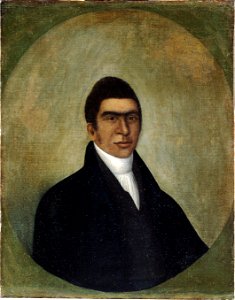Joshua johnson (occasionally spelled johnston) is one of the earliest identifiable african-american artists. Bowdoin’s portrait of a man, sometimes referred to as portrait of a cleric, is one of johnson’s few recorded images of african americans. This portrait, whose identity has yet to be discovered, exemplifies johnson’s naturalistic approach. Perhaps derived from the example of the peale family of painters, but more likely stemming from vernacular portrait traditions, johnson’s style eschewed the theatricality and painterly panache of a gilbert stuart or a thomas sully. Instead he emphasized the details of the sitter’s likeness. At the same time, he downplayed the role of color, perhaps to enhance the sobriety and dignity of his subject. In contrast to the somber mood of the painting, however, johnson gives his sitter a pleasing, easy expression that dispels the awkwardness of a formal portrait sitting. The resulting portrait suggests a man who is proper, self-confident, and pleasantly urbane. Object Type: painting. Genre: portrait. Date: between circa 1805 and circa 1810. Place of creation: Baltimore, Maryland, United States. Dimensions: 27 7/8 in. x 22 in. (70.8 cm x 55.88 cm). Medium: oil on canvas. Collection: Bowdoin College Museum of Art. Portrait of a Man (Abner Coker) by Joshua Johnson
Loading...
